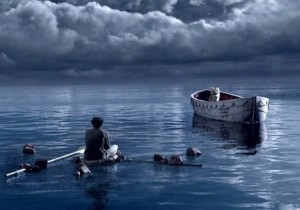[Originally published in GeneseeSun.com]
The Infinite Complexity of God and Tigers
Life of Pi, dir. Ang Lee, with Suraj Sharma
The long-awaited film adaptation of Life of Pi, Yann Martel’s novel of shipwreck, spirituality, and the food chain, hit theaters hereabouts on Thanksgiving day, appropriately enough. It was oddly refreshing, somehow, after the traditional day of over-eating, to spend two-plus hours in the dark watching this remarkable movie, with a plot driven largely by the real threat of being eaten.
The central story of the film and the novel involves a fictional Indian lad, Piscine Molitor Patel (Suraj Sharma), colorfully named after a French swimming pool, a name he later shortens creatively to the nickname “Pi.” His family runs a zoo in the Botanical Gardens in the French-speaking area of Pondicherry. Pi’s family attempts to relocate to Canada, zoo included, aboard a Japanese freighter, but a ferocious storm sinks the ship and kills all but Pi and a handful of animals, who are castaway on a lifeboat. The terrifying shipwreck, which was mostly shot in a studio set, is very effectively filmed, especially so in the white-knuckle 3D version.The animal survivors that make their way to the lifeboat – it becomes a good question whose lifeboat – are an injured zebra, an orangutan, a hyena that kills the first two, and – surprise! – a Bengal tiger hiding away under a canvas, who bursts out unexpectedly and kills the hyena. That may not be surprising, the food chain being what it is. In the drama that plays out next, though, an extraordinarily tense and drawn-out standoff ensues between Pi and the tiger (previously named Richard Parker by accident), and the two gradually develop a kind of relationship of necessity. They share an impossibly cramped space, a number of adventures, and 227 days at sea – or something like an hour of screen time – before finally beaching on the west coast of Mexico.
The film leans quite heavily on the novel, perhaps a bit too heavily; like the novel, that central story is embedded in a lengthy, sometimes tedious frame structure. The adult Pi (Irrfan Khan) tells his story to a writer (Rafe Spall) – a stand-in for the novelist, Martel, and probably the wimpiest movie version of a writer in all of film history – through on-screen interviews and voice-over flashbacks of Pi’s youth and adolescence, 40 minutes of back-story that eventually segues into the central section of the film. One waits with almost … impatience … for the shipwreck. Didn’t we all mainly come to see what happens when you put a human and a tiger together in a lifeboat?
The youthful Pi, however, is a singular child indeed, and displays a quest-like curiosity about God that leads him to explore every religion he encounters, particularly Hinduism and Christianity. The surprised writer asks Pi about the Christian-Hindu identity, and Pi explains the benefits: “I can feel guilty before hundreds of Gods!” That, unfortunately, is about as deep as the overt spirituality of the film gets. There is a moment when Pi asks a Catholic priest in Pondicherry about the core mystery of the Christian faith, about “what kind of God would sacrifice the innocent in order to save the guilty?” The answer is, basically, the usual one: “it’s a mystery.” The fact that Pi seems to accept this says more about the depth of Pi’s inquisitiveness than it does about faith or God. Pi does, it seems, genuinely want to know God. As they say, be careful what you wish for.
The deepest spirituality in Life of Pi, a film that again and again addresses the matter superficially, actually comes through the experience of nature. The harrowing survival drama plays out against a feast of stunning visual moments of the astonishing beauty and abundance of marine life and the natural world: sharks, whales, an enormous pod of dolphins, night-time seas of phosphorescent algae and jellyfish set against infinitely starry night skies, a locust-like storm of flying fish that appear at a crucial moment like manna from heaven. At one point, the two castaways, near death, encounter a hallucinatory floating island made of mangrove trees, with fresh-water ponds and a dangerous secret, for some reason absolutely swarming with millions of meerkats.
In fact, the film is populated with images of the infinite, beginning with young Pi’s chosen nickname (preferable to the humiliating English mis-pronunciation of his real name). In one long school day he introduces himself as Pi in one class after another, and finally secures his status as a legend in math class, where he writes the number pi, which has an infinite number of decimal places, on the board in a kind of math marathon that the film triumphantly cuts away from unfinished. Many of the film’s moments of amazing natural beauty are images that suggest the infinite as well: endless numbers of stars, jellyfish, flying fish, meerkats, the apparently endless ocean itself.
In the final section of the film, the writerliness of the novel again overtakes the film. Two agents from the Japanese shipping company that owned the lost freighter question the recovering Pi about his experience. They are unconvinced by his outlandish tale of tigers and hyenas and floating islands, and ask him directly for something more believable. Pi then spins an alternative story minus the zoo animals and the island that is equally implausible, with no indication of which he believes to be true. They leave dissatisfied with both versions. The film thus ends on a note of instability and uncertainty, with a glib nod to storytelling itself as the whole point, the great wonder of human life. The film offers no technical resolution of the matter, and the question itself is little more than an annoying distraction from what is, at heart, a surprising and beautiful film.
